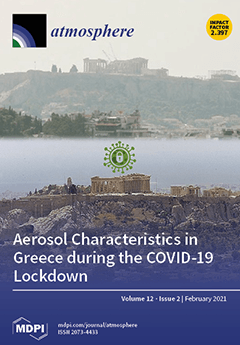This study presents the PM
10 concentration, respiratory and cardiovascular disease hospital admissions evolution in the Ciuc basin for a period of 9 years (2008–2016), taking into consideration different meteorological conditions: boundary layer, lifting condensation level, temperature-humidity index, and wind chill equivalent chart
[...] Read more.
This study presents the PM
10 concentration, respiratory and cardiovascular disease hospital admissions evolution in the Ciuc basin for a period of 9 years (2008–2016), taking into consideration different meteorological conditions: boundary layer, lifting condensation level, temperature-humidity index, and wind chill equivalent chart index. The PM
10 and hospital admissions evolution showed a very fluctuated hourly, weekly, monthly, yearly tendency. The PM
10 concentration in winter (34.72 μg/m
3) was 82% higher than the multiannual average (19.00 μg/m
3), and almost three times higher than in summer (11.71 μg/m
3). During the winter, PM
10 concentration increased by an average of 9.36 μg/m
3 due to the increased household heating. Climatological parameters have a demonstrable effect on the PM
10 concentration variation. Children, the elderly and men are more sensitive to air pollution, the calculated relative risk for men was (
RR = 1.45), and for women (
RR = 1.37), respectively. A moderate correlation (0.51) was found between PM
10 and pneumonia (P), while a relatively weak correlation (0.39) was demonstrated in the case of PM
10 and upper respiratory tract infections (URTI). Furthermore, except thermal humidity index (THI), strong negative correlations were observed between the multiannual monthly mean PM
10 and the meteorological data. The PM
10 followed a moderate negative correlation with the boundary layer (−0.61). In the case of URTI and P, the highest number of hospital admissions occurred with a 5 to 7-day lag, while the 10 μg/m
3 PM
10 increase resulted in a 2.04% and 8.28% morbidity increase. For lung cancer (LC) and cardiovascular diseases (AMI, IHD, CCP), a maximum delay of 5–6 months was found. Three-month delay and an average growth of 1.51% was observed in the case of chronic obstructive pulmonary disease (COPD). Overall, these findings revealed that PM
10 was and it is responsible for one-third of the diseases.
Full article





